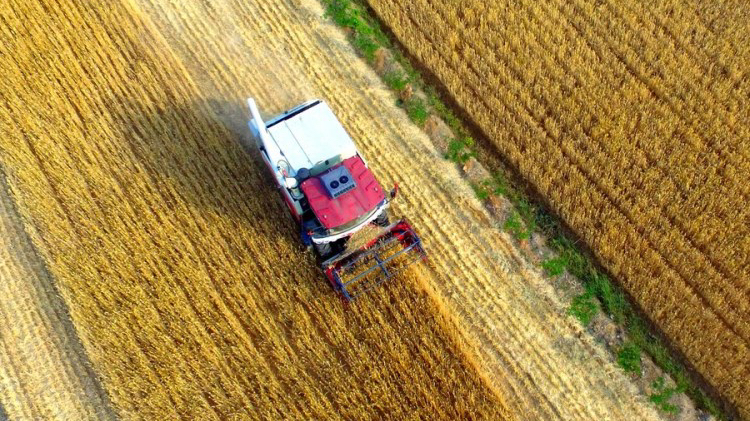
Farmers harvesting wheat in the fields in Xiapo Village of Linyi, east China's Shandong Province, May 24, 2022. /Xinhua
Farmers harvesting wheat in the fields in Xiapo Village of Linyi, east China's Shandong Province, May 24, 2022. /Xinhua
Editor's note: Xin Ge is an associate professor at the School of Public Economics and Administration, Shanghai University of Finance and Economics. The article reflects the author's opinions and not necessarily the views of CGTN.
The key document known as the "No. 1 central document" was unveiled on February 13, which underlines China's determination to "comprehensively push rural vitalization" with joint efforts of the Communist Party of China (CPC) and the whole society and make it a "strong agricultural country."
This is the 20th consecutive year that China's central authorities issued the first policy statement of the year on agricultural and rural work. This document outlines nine aspects that China will undertake to promote rural vitalization, including: stabilizing the production and supply of essential agricultural products, boosting the construction of agricultural infrastructure, strengthening support for agricultural science, technology and equipment, consolidating and expanding the achievements of poverty alleviation, promoting the high-quality development of rural industries, broadening the channels for farmers to increase their income, promoting the construction of a livable, suitable and beautiful countryside, enhancing the rural governance system led by the Party organization and strengthening policy guarantees and innovations in systems and mechanisms.
Most listed policy tasks are an extension of last year's objectives, but also offers new highlights that merit special attention.
Securing food security
The top priority is to secure grain and crucial agricultural products' supplies and stable production, a reflection of the central government's long-term concern over food security. According to this year's document, stabilizing agricultural production and supply has been uplifted to a strategic position, amid the unexpected natural disasters and geopolitical tensions.
Over the years, China has enhanced its grain production capacity. In 2022, China's grain output surpassed 650 million tons for the eighth year succesively providing a better, stronger and more stable source of grain supply for 1.4 billion people. And in 2023, China could achieve grain output of 700 million tons, given more favorable planting conditions, ebbed disruptions from the pandemic and lower prices of agricultural materials, pointed out by Tang Renjian, director of the Central Rural Work Leading Group Office and minister of Agriculture and Rural Affairs, at a press conference in Beijing on February 14.
China will stabilize its planting area while increasing production levels. Beijing will encourage the southern regions to develop grain varieties that yield more than one crop per year and carry out projects to increase soybeans and corn yields.
In the past year, the development of agricultural science and technology in China has contributed 62.4 percent of total farm output. Moreover, the 60 national-level farm technological innovation alliances were formed in China and nearly one million agricultural field professionals have offered consultancy over how to boost agricultural production levels.
The document shows the government plans to build an agricultural science and technology innovation system with a clear tier, division of cooperation and moderate competition to accelerate breakthroughs in cutting-edge technologies. By nurturing more agricultural talents and upgrading key innovation platforms and systems, the country is accumulating strategic technological power for rural development.

A farmer displaying rice seedlings in Nanchang County, east China's Jiangxi Province, July 20, 2022. /Xinhua
A farmer displaying rice seedlings in Nanchang County, east China's Jiangxi Province, July 20, 2022. /Xinhua
Preventing backsliding to poverty
Accordingly, for a revitalized countryside, no large-scale return to poverty is a bottom line to be guaranteed.
In 2021, China secured victory in the battle against absolute poverty, lifting 98.99 million rural residents out of poverty and removed all 832 impoverished countries and 128,000 villages from the poverty list.
In 2022, the annual per capita disposable income of farmers in areas that just shook off poverty grew 7.5 percent last year to 15,111 yuan (about $2,207), 1.2 percentage points higher than the national average of farmers. Moreover, the average annual income of farmers lifted them out of poverty, which has surged to a robust rate of 14.3 percent year on year to 14,342 yuan, 8 percent higher than the per capita disposable income of other rural residents.
This year's No. 1 central document also aims at increasing income and employment opportunities for all farmers, by narrowing the income gap between rich and less-affluent regions.
In 2022, 32.78 million migrant workers in China can enjoy full employment, hitting the annual target by 2.59 million more. This year, the country seeks ensure that more than 30 million people, who have shaken off poverty, are employed.
The document also notes that it's crucial for governments to cultivate industries and businesses that leverage local strengths. More than 60 percent of the central government subsidies for rural vitalization will be used to develop local industries. E-commerce platforms can provide opportunities here. In 2021, China's online retail sales of agricultural products grew 2.8 percent year-on-year to hit 422.1 billion yuan, according to a report released by the Ministry of Commerce.
It's apparent that the document's emphasis on modernizing agriculture and rural areas echoes with the blueprint laid out by the 20th CPC National Congress report, which underscored that "the most challenging and arduous tasks we face in building a modern socialist China in all respects remain in our rural areas," and President Xi's remarks at the annual Central Rural Work Conference last December, "without strong agriculture, there would be no modernized strong country; without agricultural and rural modernization, socialist modernization would be incomplete." The emphasis on the security of agricultural products and enhancement of rural residents' livelihood is manifested in the grand goal of common prosperity, which could be the most distinctive feature that defines Chinese-style modernization.
(If you want to contribute and have specific expertise, please contact us at opinions@cgtn.com. Follow @thouse_opinions on Twitter to discover the latest commentaries in the CGTN Opinion Section.)